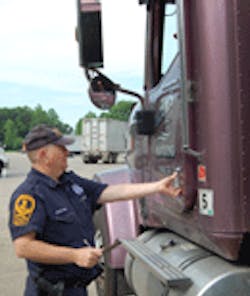CSA: A watchword at TMW Users Conference
DALLAS. A key take-away from the 24th annual TMW TransForum Users Conference here this week is that IT providers have wasted no time in developing solutions aimed squarely at assisting fleet owners with the new federal CSA safety-scoring system. Innovations announced or released go well beyond providing “scorecards” to keep on top of a fleet’s current CSA standings. Rather, they are designed to enable fleets to proactively and positively influence a driver’s score before his or her on-the-road performance can result in a negative score.
Kicking off the 24th annual user meeting—and playing to a room packed with a record number of customer and partner attendees—TMW president & CEO David Wangler took a few minutes to sum up the changes wrought on trucking since 2007, when fleets saw “freight volumes and rates start on a scary ride that felt like it might never end,” and explained the sea change in pure economic terms.
He pointed out that “freight-carrying capacity in North America is dramatically different than it was a few years ago. It’s estimated that more than 300,000 Class 8 trucks have left the market and additions to fleets are still few and far between. Carrier bankruptcies and closures took out many firms that lacked the sound financial management and diversified customer bases to help them survive the downturn. Many carriers parked trucks or sold them, and almost everyone deferred replacements as long as possible. Business failures hit the small and mid-size portions of the trucking industry significantly.
“This Darwinian reduction in market capacity has finally started to change the supply and demand balance,” he explained. “Like my economics professor told us - the laws of supply and demand are not just suggestions. Shippers are beginning to court dependable carriers and some are willing to sign up for longer contracts - a nice change from the endless bidding wars that marked early 2009. So with volumes up and capacity down, rates are starting to recover. But given that credit is still so hard to come by, it’s unlikely we’ll see many new carriers enter the market anytime soon.”
Turning to the big issue that drives trucking’s concerns about CSA, Wangler declared there is “another constraint right on the horizon that will be familiar to most of you; a shortage of safe and dependable drivers to hire. Unlike [in] previous economic cycles, there is an additional factor working to shrink the driver pool.
“The government calls it CSA and [this,] the FMCSA’s new safety rating system, is likely to reduce the available driver population even more,” he said, adding that “a driver’s poor safety record will remain part of a carrier’s safety score long after that driver has left the terminal for the last time. As a result, carriers will expend more resources in recruiting and researching the backgrounds of driver applicants. The competition between carriers to hire and retain the best drivers in the new, post-CSA world might get quite brutal. “
Wangler argued that a fleet can’t control what its drivers do on the road—but the fleet can “build an organization with a strong culture of safety, and one that demonstrates care for the well-being of your drivers” and such an effort will go “a long way in protecting your company’s important safety rating.”
As for TMW’s approach to the issue, Wangler noted it dates back to 2005 when the firm released its web portal app “DriverSea.” He said it allowed “carriers to connect more effectively with their drivers, and even for drivers to connect with their own families while away from home. Easing the stress of life on the road and building a stronger sense of company involvement and shared vision with your drivers can help you hold on to the good ones.”
And this year, he noted, TMW rolled out its new “CSA Management” portal. He said the portal enables carriers “to preview their CSA scores and let them drill down to individual drivers and violation records,” so managers can be more proactive about driver performance. “You will see more from us in the area of safety as we try to help you predict problems before they happen so you can take preventive measures,” Wangler added.
He also made it a point to mention where else IT solutions can have major impacts on fleet operations. “Business pressures and even normal competition require that we continue to increase the productivity and utilization of all available resources: trucks, drivers, mechanics and office staff,” he pointed out. “If you’re sitting in the audience here today, you might believe as I do that the best way to increase productivity, to make better business decisions, to plan strategically and improve your competitive position is through the effective use of information technology.”
